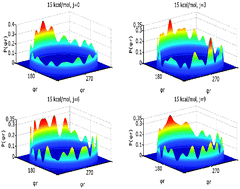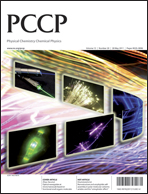Product rotational angular momentum polarization in the H + FCl(v = 0–5, j = 0, 3, 6, 9) → HF + Cl reaction
Abstract
The product alignment and orientation of the title reaction on the ground potential energy surface of 1 2A′ have been studied using the quasi-classical trajectory method. The calculations were carried out for case (a) at collision energies of 0.5–20 kcal mol−1 with the initially rovibrational state of the reagent FCl molecule being at the v = 0 and j = 0 level to especially reveal in detail the dependence of the product integral cross section on collision energy. Further calculations at the collision energy of 15 kcal mol−1 for case (b) at v = 0–5, and j = 0, and (c) at v = 0, and j = 3, 6, 9 initial states were carried out to reveal the effect of initially vibrational and rotational excitations on stereodynamics, respectively. Possessing final relative velocity k′ (defined as a vector in the xz-plane), product alignment perpendicular to the reagent relative velocity vector k (defined as z- or parallel to the z-axis), for case (a) is found to be weaker at all collision energies, for case (b) is found to be vibrationally enhanced by the reactant molecule FCl, but for case (c), rather insensitive to initially rotational excitation. The rotational vector of product molecular orientation pointing to either negative or positive direction of the y-axis in the center of mass frame, e.g. origin of the coordinate system, is enhanced by collision energies regarding to 0.5–20 kcal mol−1, while it becomes weaker at higher vibrational (v = 0–5) or rotational (j = 0, 3, 6, 9) excitation levels. Effects of collision energies and of rotational excitation at these collision energies, with 15 kcal mol−1 as an example on the calculated PDDCSs are also shown and discussed. Detailed plots P(φr) in the range of 0 ≤ φr ≤ 360o, and P(θr, φr) in the ranges of 0 ≤ θr ≤ 180° and 0 ≤ φr ≤ 360° at collision energies 0.5–20 kcal mol−1 have been presented. Overall, results of PDDCSs of the product alignment and product orientation at these collision energies in the title reaction are not very strongly distinguishable.


 Please wait while we load your content...
Please wait while we load your content...